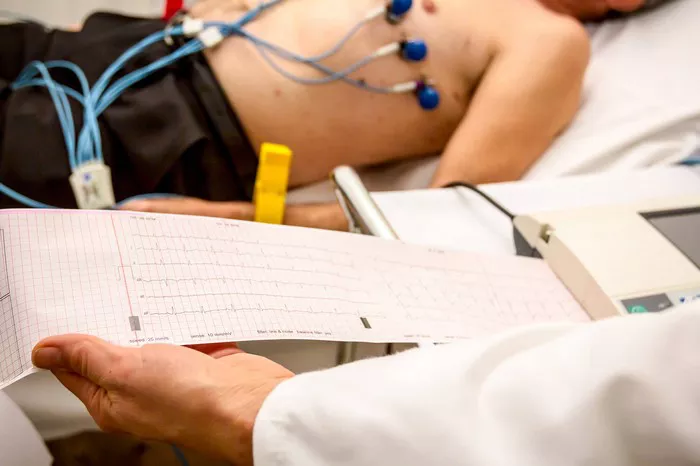Atrial fibrillation (AFib) stands as a significant concern within the realm of cardiovascular diseases, affecting millions globally. Characterized by rapid and irregular heartbeats, this condition not only disrupts the heart’s efficiency but also raises the ominous risk of stroke, heart failure, and other heart-related complications. In the diagnostic arsenal against cardiac ailments, the Electrocardiogram (EKG or ECG) emerges as a fundamental tool. This non-invasive test records the electrical activity of the heart, offering vital clues about its condition and functioning. This article delves into the efficacy of EKG in detecting AFib, unraveling the complexities of interpretation and its critical role in the management of the condition.
The Fundamental Mechanism of EKG: A Brief Overview
To appreciate the diagnostic capability of EKG, a basic understanding of its mechanism is essential. An EKG machine measures the electrical impulses generated by the heart as it beats. These impulses are captured via electrodes attached to the skin at strategic points around the heart. The recorded signals are then depicted as waves on a graph, providing a visual representation of the heart’s electrical activity over time. The P wave, QRS complex, and T wave are the primary components analyzed in an EKG, each corresponding to a specific phase of the cardiac cycle.
AFib and Its Electrophysiological Signature
AFib is distinguished by a rapid and chaotic heartbeat, which arises from abnormal electrical impulses in the atria, the heart’s upper chambers. This arrhythmia disrupts the coordinated movement of electrical signals through the heart, leading to an irregular and often rapid heart rate. On an EKG, AFib is primarily identified by the absence of distinct P waves and the presence of erratic, rapid oscillations or fibrillatory waves. The irregularity in the timing of the QRS complexes, which represent ventricular contractions, is another hallmark of AFib on an EKG reading.
Interpreting EKG Results: The Clues to Detecting AFib
An EKG provides a snapshot of the heart’s electrical activity, offering clues that are pivotal in diagnosing AFib. The key indicators of AFib on an EKG include:
1. Absence of P Waves: In AFib, the atria contract in a rapid and disorganized manner, which leads to the absence of distinct P waves on the EKG.
2. Irregular R-R Intervals: The intervals between successive QRS complexes (R-R intervals) are irregular, reflecting the erratic conduction of impulses through the AV node into the ventricles.
3. Fibrillatory Waves: Instead of normal P waves, fine or coarse fibrillatory waves are seen, indicative of the chaotic electrical activity in the atria.
The Role of EKG in AFib Management
The detection of AFib through EKG is not just diagnostic but also instrumental in guiding treatment strategies. The EKG can help in assessing the severity of the condition, monitoring the effectiveness of treatment, and guiding decisions regarding the necessity of interventions such as cardioversion, ablation, or the initiation of anticoagulant therapy to prevent stroke.
Advanced EKG Techniques and AFib
While a standard 12-lead EKG is effective in diagnosing AFib, certain situations may call for advanced techniques for a more detailed analysis:
1. Holter Monitor: A continuous EKG recording, typically over 24-48 hours, can capture intermittent episodes of AFib that a standard EKG might miss.
2. Event Recorders: For sporadic AFib episodes, event recorders can monitor heart activity over weeks or months, recording abnormalities as they occur.
3. Smartphone-based EKG Monitors: Recent advancements have introduced portable devices that allow for instant EKG recording and analysis, facilitating early detection and management of AFib.
Challenges in EKG Interpretation for AFib Detection
Despite its effectiveness, EKG interpretation for AFib detection is not without challenges. The quality of the recording, patient movement, and the presence of other cardiac or non-cardiac conditions can complicate the analysis. Additionally, the distinction between AFib and other types of arrhythmias, such as atrial flutter or supraventricular tachycardia, requires a nuanced understanding of EKG patterns and clinical judgment.
The Future of EKG and AFib Diagnosis
The future of EKG technology promises enhancements in accuracy, accessibility, and interpretative algorithms, potentially powered by artificial intelligence (AI). These advancements could revolutionize the detection and management of AFib, making it more precise and personalized.
Conclusion
The EKG remains a cornerstone in the diagnosis and management of atrial fibrillation, offering a window into the heart’s electrical activity. Its non-invasive nature, coupled with the depth of information it provides, makes it an invaluable tool in the fight against AFib. As technology advances, the potential for even more accurate and accessible EKG-based diagnostics is on the horizon, promising a future where AFib can be detected and treated with even greater efficacy.

